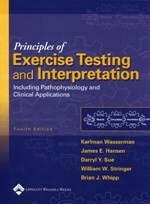
Principles of Exercise Testing and Interpretation
Including Pathophysiology and Clinical Applications
Seiten
2004
|
4th Revised edition
Lippincott Williams and Wilkins (Verlag)
978-0-7817-4876-6 (ISBN)
Lippincott Williams and Wilkins (Verlag)
978-0-7817-4876-6 (ISBN)
- Titel erscheint in neuer Auflage
- Artikel merken
Zu diesem Artikel existiert eine Nachauflage
A reference to address those disorders that can be diagnosed only through cardiopulmonary exercise testing. This book provides comprehensive presentation addressing cardiovascular, metabolic, and respiratory responses to exercise - in both health and disease states.
Thoroughly updated in its Fourth Edition, this exceptional resource is the most comprehensive, current text on the physiology and pathophysiology of exercise testing available. It is the only reference to address those disorders that can be diagnosed only through cardiopulmonary exercise testing. In this book readers will find: comprehensive presentation addressing cardiovascular, metabolic, and respiratory responses to exercise - in both health and disease states; principles and rationale behind exercise testing, commonly used testing protocols, guidelines for normal and abnormal values, and tips for accurate interpretation of test results; normal test values for a range of patient groups -including children, over - and underweight patients, and the elderly; more than 80 case histories, each accompanied by exercise physiology results, highlight differential diagnosis by applying basic physiological concepts to real-world examples; and coverage of disorders that can be diagnosed only through cardiopulmonary exercise testing.New to the Fourth Edition contains: new chapter covering regulation of arterial and mixed venous blood gases; new nine-panel graphic array illustrating critical aspects of exercise testing;and updated flow charts to help with clinical interpretation and differential diagnosis.
Thoroughly updated in its Fourth Edition, this exceptional resource is the most comprehensive, current text on the physiology and pathophysiology of exercise testing available. It is the only reference to address those disorders that can be diagnosed only through cardiopulmonary exercise testing. In this book readers will find: comprehensive presentation addressing cardiovascular, metabolic, and respiratory responses to exercise - in both health and disease states; principles and rationale behind exercise testing, commonly used testing protocols, guidelines for normal and abnormal values, and tips for accurate interpretation of test results; normal test values for a range of patient groups -including children, over - and underweight patients, and the elderly; more than 80 case histories, each accompanied by exercise physiology results, highlight differential diagnosis by applying basic physiological concepts to real-world examples; and coverage of disorders that can be diagnosed only through cardiopulmonary exercise testing.New to the Fourth Edition contains: new chapter covering regulation of arterial and mixed venous blood gases; new nine-panel graphic array illustrating critical aspects of exercise testing;and updated flow charts to help with clinical interpretation and differential diagnosis.
- Exercise Testing and Interpretation: An Overview Why Measure Gas Exchange to Evaluate Cardiovascular Function and Cellular Respiration? Cardiac Stress Test and Pulmonary Stress Test: Nomenclature and Fallacies Cell Respiration and Bioenergetics Normal Coupling of External to Cellular Respiration Quantifying State and Time Course of Cellular Respiration from Measurements Of External Respiration Patterns of Change in External Respiration (O2 Uptake and CO2 Output) as Related to Function, Fitness and Disease Factors Limiting Exercise Fatigue Dyspnea Pain Evidence of Systemic Dysfunction Uniquely Revealed by Integrative Cardiopulmonary Exercise Testing Physiology of Exercise Skeletal Muscle Mechanical Properties and Fiber Types Energetics Oxygen Cost of Work Work Efficiency VO2 Non-Steady State Lactate Increase Lactate Increase as Related to Work Rate Lactate Increase as Related to Time Lactate Increase in Response to Increasing Work Rate Mechanisms of Lactate Increase Buffering the Exercise-induced Lactic Acidosis The Anaerobic Threshold (AT) Concept Identifying AT by Gas Exchange Altered Physiological Responses to Exercise Above the AT Anaerobic, Lactate and Lactic Acidosis Thresholds Metabolic-Cardiovascular-Ventilatory Coupling Cellular Respiration and High Energy Phosphate Regeneration Cardiovascular Coupling to Metabolism: Muscle O2 Supply Ventilatory Coupling to Metabolism Effect of Dietary Substrate Control of Breathing Overview Acid-Base Regulation Physical Factors Reflexes Regulating Breathing During Exercise Gas Exchange Kinetics Oxygen Uptake Kinetics CO2 Output Kinetics Measurements During Integrative Cardiopulmonary Exercise Testing What is an Integrative Cardiopulmonary Exercise Test? When Should Integrative Cardiopulmonary Exercise Testing Be Used? Measurements Electrocardiogram Maximal Oxygen Uptake (VO2max) Maximum Oxygen Uptake (Peak VO2) Oxygen Uptake and Work Rate Pattern of Work Rate Increase and the VO2 Response Upward Displacement of VO2 as A Function of Work Rate Cardiac Output and Stroke Volume Anaerobic (Lactate, Lactic Acidosis) Threshold (AT, LT, LAT) Heart Rate-Oxygen Uptake Relationship and Heart Rate Reserve Oxygen Pulse (VO2/HR) and Stroke Volume Arterial Blood Pressure Breathing Reserve Expiratory Flow Pattern Tests of Uneven VA/Q Arterial Bicarbonate and Acid-Base Response Tidal Volume/Inspiratory Capacity Ratio (VT/IC) Measurements Unique to Constant Work Rate Exercise Testing Data Display and Interpretation Pathophysiology of Disorders Limiting Exercise Obesity Peripheral Arterial Diseases Heart Disease Coronary Artery Disease Myopathic Heart Disease Valvular Heart Disease Congenital Heart Disease
| Erscheint lt. Verlag | 1.11.2004 |
|---|---|
| Zusatzinfo | illustrations |
| Verlagsort | Philadelphia |
| Sprache | englisch |
| Maße | 216 x 280 mm |
| Gewicht | 1634 g |
| Themenwelt | Studium ► 1. Studienabschnitt (Vorklinik) ► Physiologie |
| ISBN-10 | 0-7817-4876-3 / 0781748763 |
| ISBN-13 | 978-0-7817-4876-6 / 9780781748766 |
| Zustand | Neuware |
| Informationen gemäß Produktsicherheitsverordnung (GPSR) | |
| Haben Sie eine Frage zum Produkt? |
Mehr entdecken
aus dem Bereich
aus dem Bereich



